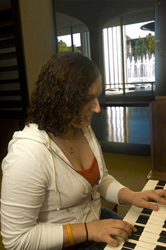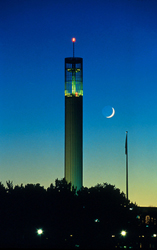Restored UAlbany Carillon Rings in Improved Sounds and Early Warning System
Enhanced sound system restores UAlbany musical tradition while addressing new era of emergency preparedness
Contact(s): Catherine Herman (518) 956-8150, ([email protected])
 |
| Sophomore Leah Rotella, vice-chair of the Student Senate from Coram, N.Y., explores the carillon keyboard. (Photo Mark Schmidt) |
UAlbany Interim President George Philip will rededicate the restored carillon, joined by former Alumni Association President and Honorary Chairman of "Project Carillon" Kenneth Doran '39, and student Allyson Sara Impallomeni.
"The carillon is an architectural feature that distinguishes our University and is one of our most enduring alumni gifts," said Interim President Philip. "Now, with its enhanced capacity for early warnings, it is also an important element of our campus safety plan."
The carillon, set atop the University's iconic Edward Durell Stone-designed water tower on the Academic Podium, was a gift of the Alumni Association, and was first installed at Stuyvesant Tower on Dutch Quad in 1966. To acquire the carillon, the Association formed "Project Carillon," which raised the extraordinary amount of $30,000 from more than 1,680 donations. In 1972 the carillon was moved to the 250-foot tower and for the next 35 years pealed the Alma Mater and other University tunes at special occasions, and the time of the day on the hour and half-hour.
"The association wanted to pay tribute to the school and at the same time contribute to its growing traditions," said Honorary Chairman of Project Carillon Kenneth Doran '39. "We are honored to be part of today's ceremony, and pleased to see that the carillon has emerged with new functionality as one of the University's strongest traditions."
The recent renovation was carried out by Maas-Rowe Carillons of Escondido, California, the company that installed the original carillon. The system is a complex, organ-like musical instrument called a Symphonic Carillon, which uses a keyboard, called a "baton console," and a unique method to amplify chimes to simulate the sounds of the larger variable-sized bells that were and are still used in the church towers of Europe. In the Middle Ages, the original carillons of Europe were used as early warning systems, with distinct tones and rhythms notifying the surrounding area of storms, fires, and attacks. They were also used to signal happier events, such as the birth of a child or a religious event. The great carillons began to take on entertainment duties in the 14th century, when they were used to play music for festivals.

|
| The Carillon Tower at night, framed by a sliver of the moon. UAlbany will rededicate the restored carillon in a special ceremony on Friday, Oct. 17. (Photo Mark Schmidt) |
The City of Albany will herald the re-emergence of the UAlbany instrument by ringing its carillon in a special tribute at noon on the same day. The City of Albany carillon, located downtown at City Hall, was dedicated in 1927, and with 49 bells and a range of four octaves, the instrument is one of 100 concert level carillons in North America.
"As an alumnus, I've always known that it�s the people and our traditions that make the University at Albany a great institution," said Albany Mayor Gerald D. Jennings '76. "On behalf of the City of Albany I'd like to welcome this carillon back to the family of magnificent carillons that ring throughout the Capital Region."
In addition to its function to play live music and public addresses, the carillon has the capacity to play pre-recorded music, and will be featured at the Oct. 25th UAlbany Day. The day is designed to highlight the richness of the University's academics and campus life with faculty and student demonstrations, facility tours, open dress rehearsals, art exhibits, a farmer's market, basketball scrimmages, and recycling demonstrations.
[email protected]
